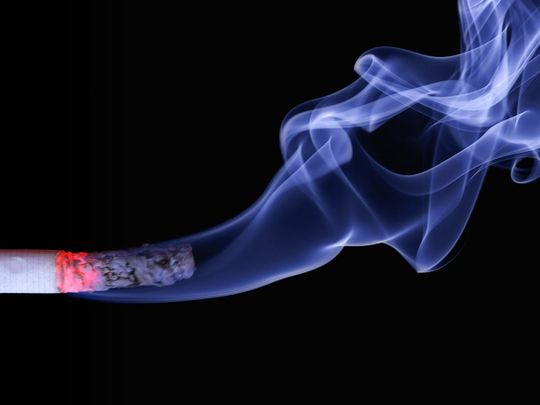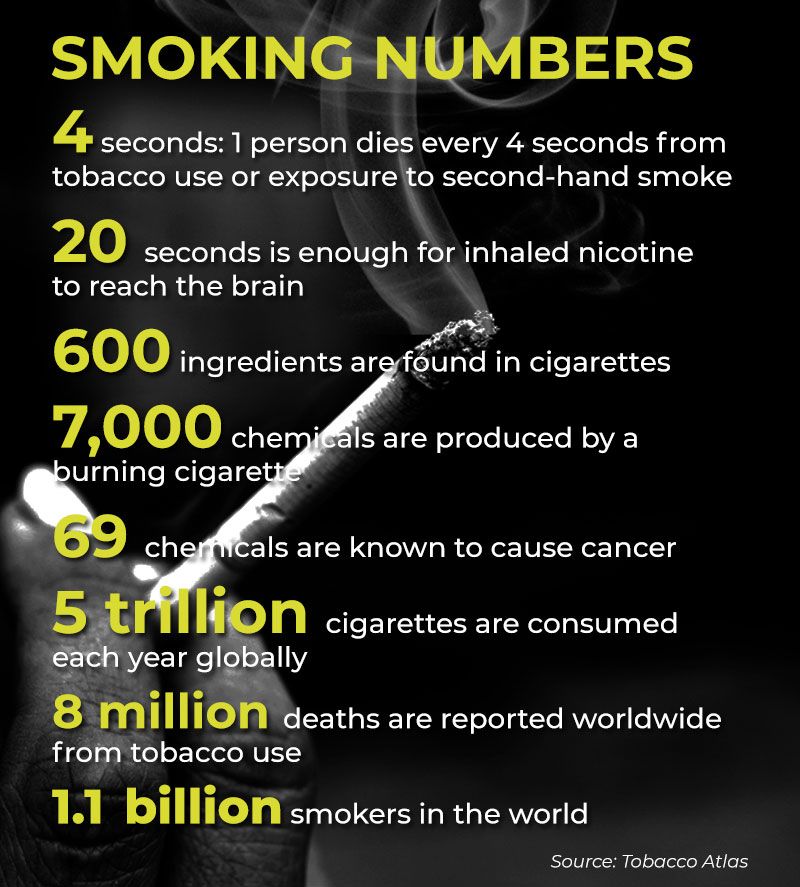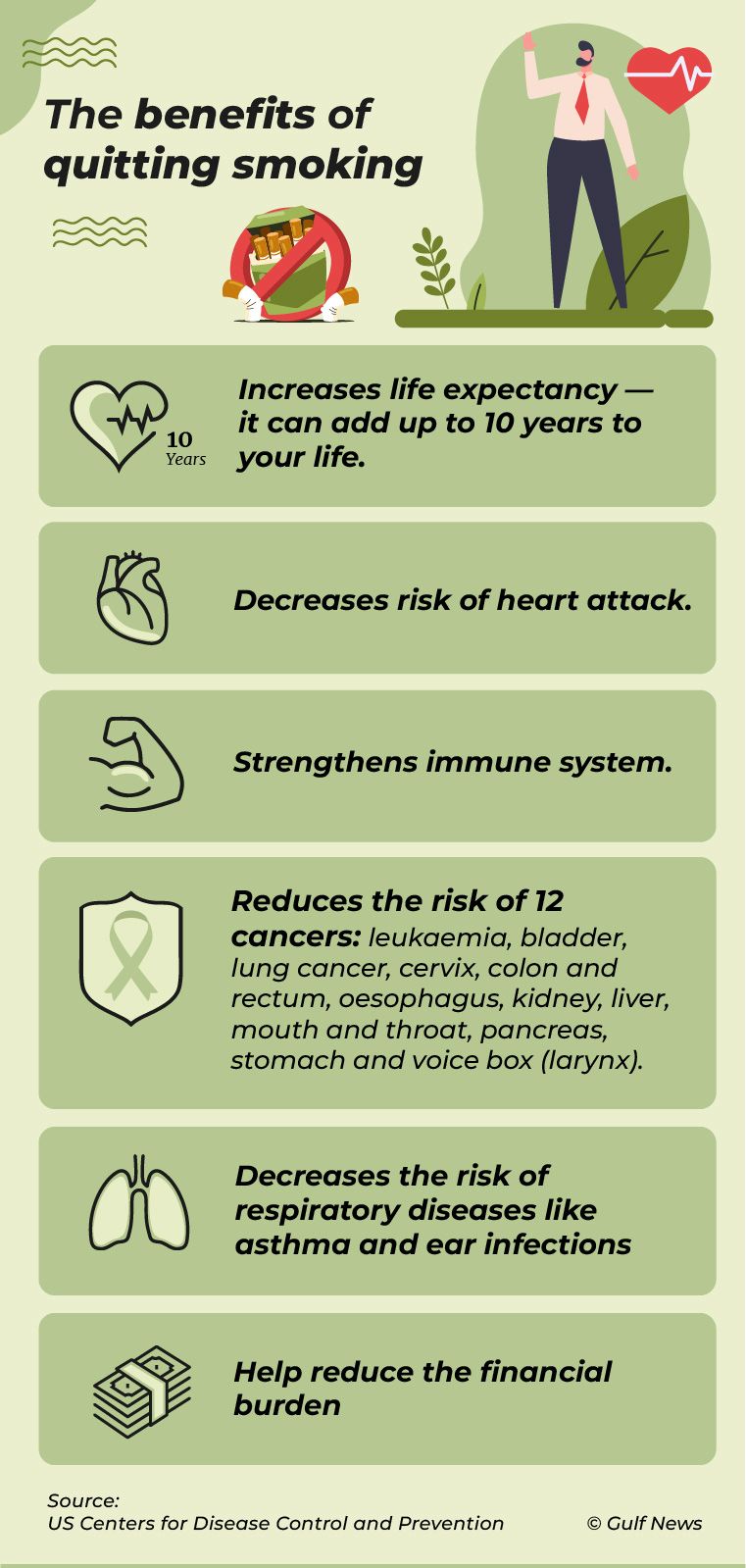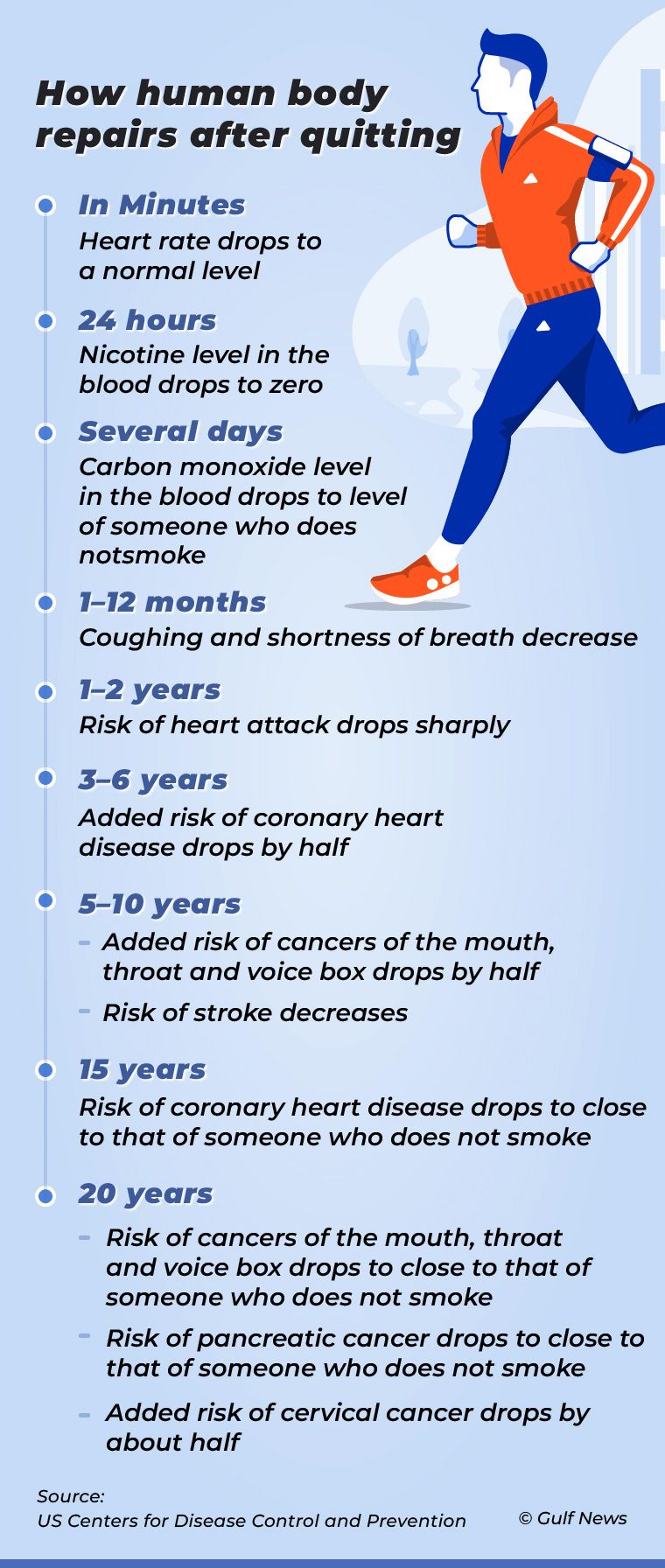
Smoking can kill. We know that. If you didn’t, here are some stats from the World Health Organisation. One person dies every four seconds from tobacco use or exposure to second-hand smoke. That’s more than 22,000 deaths every day and over 8 million each year.
Alarming it may be, but hardly surprising given the damage smoking inflicts on the human body. It harms every organ, leading to disease, disability and even death. That’s what doctors say.
Some diseases caused by smoking are cancer, heart disease, stroke, lung diseases, diabetes, and chronic obstructive pulmonary disease (COPD), according to the US Centers for Disease Control and Prevention. Smoking also increases the risk of tuberculosis and some eye diseases, and weakens the immune system.
What makes cigarettes deadly?
Cigarettes contain around 600 ingredients, and a burning cigarette produces more than 7,000 chemicals. At least 69 of them are known to cause cancer, while many others are toxic, according to the American Lung Association.
What are the chemicals in cigarettes?
The main chemical constituents of cigarettes listed by the Irish Cancer Society include:
Nicotine: The poisonous alkaloid affects the brain and is very addictive.
Tar: The sticky brown chemical cocktail formed when tobacco cools collects in the lungs and can cause cancer.
Carbon monoxide: The gas released from burning tobacco enters the bloodstream and harms the heart and the blood vessels.
Arsenic: A common ingredient of rat poison, small quantities are found in cigarette smoke from the pesticides used in tobacco farming.
Ammonia: Compounds of the toxic gas are commonly used in cleaning products and fertilisers.
Acetone: Fragrant volatile liquid ketone is a solvent, commonly found in nail polish remover.
Toluene: A highly toxic chemical, its industrial uses are in manufacturing rubber products, oils, resins, adhesives, inks, detergents, dyes and explosives.
Methylamine: Found in tanning lotion.
Methanol: Fuel used in the aviation industry.
Metals: Several metals, including arsenic, beryllium, cadmium, chromium, cobalt, lead and nickel, can cause cancer.
Radioactive compounds: Radioactive materials like Polonium – 210 are known to be carcinogenic.
Other ingredients: They include acetic acid (found in disinfectants), naphthalene (used in making mothballs), hydrogen cyanide (a poison), acetanisole (used to make perfumes), methane and urea.

From tobacco plant to smoke — the chemical route
■ Nicotine is produced by the tobacco plant as a pesticide against insects and animals.
■ Toxins such as lead, nitrates and cadmium build up in the plant as it grows.
■ Cancer-causing chemicals called tobacco-specific nitrosamines (TSNAs) are formed during the curing process of tobacco leaves.
■ More chemicals are added to tobacco to control moisture, enhance flavour and reduce harshness.
■ Sugars used for masking harshness can result in the formation of a cancer-causing chemical called acetaldehyde.
■ When a cigarette burns, chemicals in tobacco leaves change into new and more plentiful chemicals. Some of them are carbon monoxide, butadiene, acrolein and benzene. They are all highly toxic.
What are the additives in cigarette tobacco?
Tobacco companies were secretive about the ingredients in cigarette tobacco. But that changed after two legislations were enacted in the United States. In 1994, five major American cigarette companies submitted to the US Department of Health and Human Services a list of 599 additives.
In the US, these ingredients have been approved as food additives but were not tested by heating or burning. That can change their properties and may even be toxic.
US Food and Administration spokesman Jim O’Hara said in 1994: “If it’s approved for use in food, that means there’s been the appropriate testing that shows it can be safely digested. That doesn’t speak one way or the other to the safety of something ... that is burning and is inhaled into the bloodstream.”
What happens during smoking?
According to the US National Institute on Drug Abuse, the following series of actions occurs during smoking:
■ Cigarettes are designed to deliver nicotine to the human brain in seconds.
■ The average smoker inhales 1–2 milligrams of nicotine per cigarette.
■ Nicotine rapidly reaches peak levels in the bloodstream and reaches the brain.
■ In smokers who don’t inhale, nicotine is absorbed through mucous membranes in the mouth and reaches peak blood and brain levels more slowly.
■ Exposure to nicotine stimulates the adrenal glands, resulting in the discharge of epinephrine (adrenaline).
■ Adrenaline rush causes an increase in blood pressure, respiration, and heart rate.
■ Like other drugs, nicotine also activates reward pathways in the brain that regulate reinforcement and feelings of pleasure.
Immediately, dopamine is released in the brain, giving people a good feeling. When dopamine levels crash, the brain begins to crave that feeling from nicotine. This is the addiction cycle.
Nicotine can also give an energy boost or help focus as it reacts with the adrenal glands to release adrenaline into the body.
What are cancer-causing chemicals in cigarette smoke?
These are some of the known carcinogenic chemical compounds produced by a burning cigarette, according to the US National Institute on Drug Abuse:
Acetaldehyde: used to produce acetic acid and butadiene
Acrylonitrile: used in the manufacture of plastic
Aminobiphenyl: prohibited in several countries
Arsenic: a highly regulated potent poison
Benzene: a toxin used as a pesticide, petrol and explosives manufacturing
Beryllium: can cause a pulmonary condition called chronic berylliosis
Cadmium: used to produce batteries and in nuclear fission processes
Ethylene oxide: high doses cause acute poisoning
Formaldehyde: an embalming fluids
Furan: increases the risk of hepatocellular and bile duct tumours
Hydrazine: used in rocket fuel, fuel cells, and pesticides
Isoprene: used in the production of rubber
Lead: causes microcytic anaemia and interferes with cognition
Polonium-210: highly toxic, radioactive isotope
o-Toluidine: causes DNA damage which results in tumours

Effects of smoking tobacco on the body
Inhaling tobacco smoke causes damage to many of the body’s organs and systems, according to Better Health Channel.
Respiratory system
■ Irritation of the trachea (windpipe) and larynx (voice box)
■ Reduced lung function and breathlessness due to swelling and narrowing of the lung airways and excess mucus in the lung passages
■ Impairment of the lungs’ clearance system, resulting in lung irritation and damage
■ Risk of lung infection
■ Permanent damage to the air sacs of the lungs.
Circulatory system
■ Raised blood pressure and heart rate
■ Constriction of skin blood vessels, resulting in a decline in skin temperature
■ Less oxygen in the blood
■ ‘Stickier’ blood, which increases clotting risk
■ Damage to artery linings
■ Reduced blood flow to fingers and toes
■ Higher risk of stroke and heart attack due to blockages of blood vessels
Immune system
■ Risk of infections such as pneumonia and influenza
■ Severe and longer-lasting illnesses
■ Lower levels of protective antioxidants in the blood
Musculoskeletal system
■ Tightening of some muscles
■ Reduced bone density
Sexual organs
MEN:
■ Low sperm count
■ Higher percentage of deformed sperm
■ Genetic damage to sperm
■ Impotence due to damage to the blood vessels
WOMEN:
■ Reduced fertility, menstrual cycle irregularities, or absence of menstruation
■ Early menopause
■ Increased risk of cervical cancer
■ Higher risk of stroke and heart attack

Other effects on the body
■ Irritation and inflammation of the stomach and intestines
■ Risk of painful ulcers along the digestive tract
■ Reduced ability to smell and taste
■ Premature wrinkling of the skin
■ Higher risk of blindness
■ Gum disease or periodontitis
Effects of smoking on babies
A mother’s smoking can affect an unborn baby. The effects include:
■ Risk of miscarriage, stillbirth and premature birth
■ Weaker lungs
■ Low birth weight, leading to poor growth and an increased risk of heart disease, high blood pressure and diabetes
■ Increased risk of cleft palate and cleft lip
■ Risk of attention deficit hyperactivity disorder (ADHD).
read more
- Want to quit smoking? Here’s how you can get help in Abu Dhabi
- Chronic smoker of 30 years, who comes clean, shares his inspiring story in the UAE
- World No Smoking Day: How I quit smoking after repeated failures
- 25 cigarettes a day for 25 years – how a Dubai software engineer finally quit smoking
- Is vaping less harmful than smoking? Think again
Diseases caused by long-term smoking
■ Cancer of the lung, mouth, nose, larynx, tongue, nasal sinus, oesophagus, throat, pancreas, bone marrow (myeloid leukaemia), kidney, cervix, ovary, ureter, liver, bladder, bowel and stomach
■ Lung diseases such as chronic bronchitis and chronic obstructive pulmonary disease, which includes obstructive bronchiolitis and emphysema
■ Heart disease and stroke
■ Ulcers of the digestive system
■ Osteoporosis and hip fracture
■ Poor blood circulation in feet and hands, which can lead to pain and, in severe cases, gangrene and amputation
■ Type 2 diabetes
■ Rheumatoid arthritis.
Why smoking is an epidemic
There were 1.1 billion smokers last year, and a further 200 million used other tobacco products, according to the Tobacco Atlas. That makes it an epidemic that caused $2 trillion in economic damage.
Nearly 5 trillion cigarettes are consumed yearly, but tobacco usage is declining in wealthy countries. The progress in the fight is slower in poorer nations, targeted by the tobacco industry, Vital Strategies, a leading global public health organisation, says.
Rich countries should help the poor to kick the habit. Or else millions will die.









